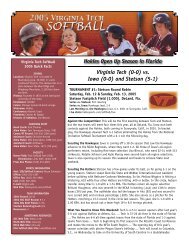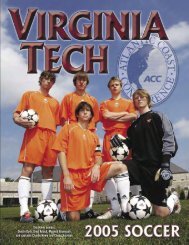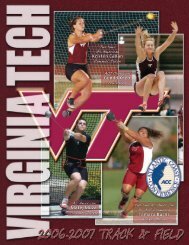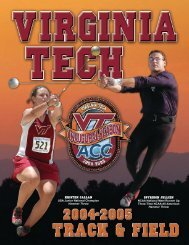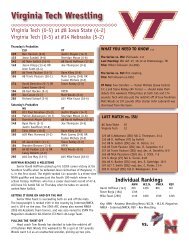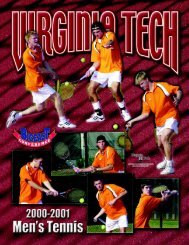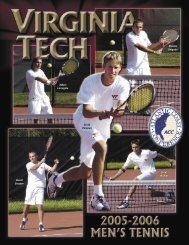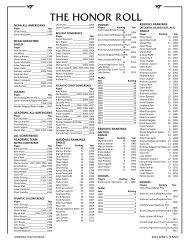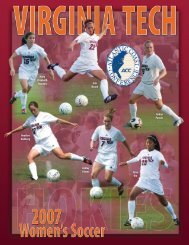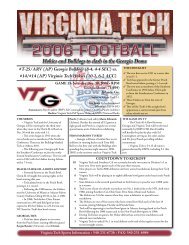Create successful ePaper yourself
Turn your PDF publications into a flip-book with our unique Google optimized e-Paper software.
media<br />
172<br />
Charles steger<br />
uniVerSity preSident<br />
Now in his thirteenth year as President of<br />
Virginia Tech, Dr. Charles Steger is pursuing the<br />
course he laid out to establish Virginia Tech among<br />
the nation’s premier research institutions. Steger<br />
has provided visionary leadership in the creation<br />
and implementation of a bold vision and strategic<br />
plan, with a demand for quality across all aspects<br />
of the academic enterprise. Among the highlights<br />
of his presidency to date are the university’s<br />
adoption of the Principles of Community (2005)<br />
and the Virginia Tech Climate Action Commitment<br />
(2009). In the minds of many, Steger will best be<br />
remembered for making the impossible a reality.<br />
He will be forever credited with negotiating<br />
Virginia Tech’s entrance into the Atlantic Coast<br />
Conference in 2004 – a 50-year dream-<strong>com</strong>e-true<br />
for Hokie fans. He is currently the Chairman of<br />
the Bowl Championship Series (BCS) Presidential<br />
Oversight Committee.<br />
One of the most exciting new initiatives to<br />
be<strong>com</strong>e reality was the <strong>com</strong>pletion of the new<br />
144,000-square-foot Virginia Tech Research<br />
Center-Arlington (VTRC-A) in 2011 to enhance<br />
the university’s presence in the National Capital<br />
Region and ability to <strong>com</strong>pete for major research<br />
grants and contracts.<br />
In addition, the Virginia Tech Carilion<br />
Research Institute is fully operational in a new<br />
152,000-square-foot building in Roanoke. VTCRI<br />
is now the hub for the world-wide interactive<br />
functional brain imaging network.<br />
Another initiative on the horizon is the new<br />
Center for the Arts that will open in the fall of<br />
2013. This 130,000-square-foot facility will feature<br />
a 1,300-seat performance hall, visual art galleries,<br />
and innovative creative technology lab spaces. At<br />
the intersection of North Main Street and Alumni<br />
Mall, its location symbolizes the university’s<br />
<strong>com</strong>mitment to the arts and its importance to the<br />
university and the broader <strong>com</strong>munity.<br />
Since Steger became president, the university<br />
has added over 2.4 million square feet of space,<br />
mostly in new construction. This surpasses all<br />
growth that occurred over the entire period<br />
between 1872 and 1960.<br />
During his tenure, the university’s annual<br />
research expenditures have increased more than<br />
300 percent, now topping $450 million. According<br />
to the National Science Foundation (NSF), Virginia<br />
Tech is the only Virginia university to rank in the<br />
top 50 out of 679 universities in the nation in<br />
sponsored research. Shortly after Steger took<br />
office, the university launched the Virginia<br />
Bioinformatics Institute, which has already<br />
secured well over $100 million in external research<br />
funding. Virginia Tech has also partnered with a<br />
number of other universities to further leverage its<br />
research strengths and resources, including Johns<br />
Hopkins University, Wake Forest University, the<br />
University of Virginia, the University of Maryland,<br />
and Georgetown University. Concurrent with the<br />
expanding research agenda, the university has<br />
expanded its outreach efforts like never before. For<br />
2012 Virginia Tech fooTball<br />
example, Virginia Tech has partnered in numerous<br />
initiatives in Southside Virginia, including<br />
the renowned Institute for Advanced Learning<br />
and Research (IALR), which are advancing<br />
both educational and economic development<br />
opportunities.<br />
A hallmark of Steger’s administration is his<br />
<strong>com</strong>mitment to the students. With his leadership,<br />
the university has reaffirmed its core mission<br />
of undergraduate education. The university<br />
is dedicated to fostering a research-intensive<br />
environment that offers students an opportunity to<br />
learn the scientific process while enhancing their<br />
critical-thinking skills. Recognizing that graduates<br />
will be entering a global economy, Virginia<br />
Tech initiated a <strong>com</strong>prehensive International<br />
Strategic Plan and has doubled the number of<br />
students participating in international education<br />
opportunities.<br />
In 2010, Steger was selected as a recipient of<br />
the Michael P. Malone International Leadership<br />
Award, sponsored by the Association of Public and<br />
Land-grant Universities. During his presidency, five<br />
international centers have been established around<br />
the globe, and another is being developed in<br />
India. While dean of CAUS, Steger was the driving<br />
force behind the establishment of Virginia Tech’s<br />
Center for European Studies and Architecture in<br />
Switzerland, which has hosted hundreds of study<br />
abroad students from departments across the<br />
university.<br />
Another of the most memorable contributions<br />
of Steger’s administration was his role in the<br />
Higher Education Restructuring Act, which took<br />
effect in July 2006. Steger was one of the leaders<br />
among university presidents to help define a<br />
ground-breaking new relationship between the<br />
<strong>com</strong>monwealth of Virginia and its colleges and<br />
universities, which enables greater institutional<br />
flexibility and potential for growth. This<br />
legislation was intended to enable Virginia Tech to<br />
perform long-range planning, ensure a stable and<br />
predictable revenue stream, and ultimately ensure<br />
a quality education for its students.<br />
In 2011, the university successfully <strong>com</strong>pleted<br />
an aggressive fundraising campaign to “invent<br />
the future,” surpassing the $1 billion goal by<br />
more than $100 million. These funds provide<br />
the university with a margin of excellence for its<br />
academic agenda. Private support from Virginia<br />
Tech’s alumni and friends continues to play an<br />
essential role in this university <strong>com</strong>munity.<br />
Virginia Tech remains one of the most<br />
<strong>com</strong>petitive institutions in the state. The university<br />
received more than 20,000 applications for the<br />
class entering in the fall of 2012. Students offered<br />
admission posted an average math and critical<br />
reading SAT score of 1251 and an average high<br />
school GPA of 4.0. The number of students from<br />
underrepresented groups who were offered and<br />
accepted admission is up slightly over last year.<br />
Steger received his Bachelor of Architecture<br />
degree, Master of Architecture degree, and Ph.D.<br />
in Environmental Science and Engineering from<br />
Virginia Tech. His passion for teaching led him to<br />
leave a career in the private sector as a professional<br />
architect and planner to return to Virginia Tech<br />
to teach in the College of Architecture and Urban<br />
Studies (CAUS). When he became Dean in 1981 at<br />
the age of 33, he was the youngest architecture<br />
dean in the nation. After 12 years in that role,<br />
he was appointed Vice President for Development<br />
and University Relations (1993-2000) before being<br />
named President in 2000.<br />
Dr. Steger has been President of the Council<br />
of Presidents of the Southeastern Universities<br />
Research Association (SURA). He is a member<br />
of the National Council on Competitiveness, the<br />
Association of Governing Boards, the Economic<br />
Club of Washington, D.C., the National Institute<br />
of Building Sciences (NIBS), the Senior Advisory<br />
Group of the Northern Virginia Technology Council<br />
Board of Directors, and the Board of the Innovative<br />
Technology Authority that oversees Virginia’s<br />
Center for Innovative Technology. He is Chairman<br />
of the Virginia Council of Presidents and chair of<br />
the Virginia Space Grant Consortium. He serves<br />
on the Council of Higher Education’s General and<br />
Professional Advisory Committee and the Virginia<br />
Business Higher Education Council. He has been<br />
appointed by five Governors of Virginia to serve on<br />
various entities including the Steering Committee<br />
of the Governor’s Higher Education Summit,<br />
Virginia Institute for Defense and Homeland<br />
Security, and the Secure Virginia Initiative. In May<br />
2010, he was named to the Governor’s Commission<br />
on Higher Education Reform, Innovation, and<br />
Investment. His most recent publications include<br />
book chapters on the topics of the business of<br />
education and the university presidency.<br />
Steger is a Fellow in the American Institute of<br />
Architects (AIA) and holds the William C. Noland<br />
Award and the Distinguished Achievement Award<br />
from the Virginia Society AIA. The New Century<br />
Technology Council awarded him its 2004 Compass<br />
Award for visionary thinking and leadership in the<br />
field of information technology.<br />
Credited with calm leadership during a very<br />
difficult period, President Steger led the university<br />
through an extended recovery period in the<br />
aftermath of the April 2007 tragedy.<br />
In 2009, President Steger received the Chief<br />
Executive Leadership Award from the Council for<br />
the Advancement and Support of Education (CASE)<br />
District III for outstanding leadership and service<br />
in support of education.







